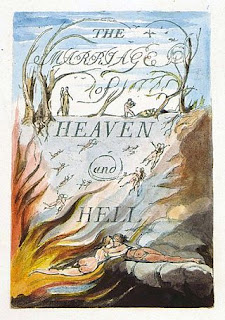Challenging Conventions: The Marriage of Heaven and Hell by William Blake
[A free pdf copy of The Marriage of Heaven and Hell can be found in the Free Lit Archive]
The Marriage of Heaven and Hell is a visionary and complex work by the English poet, artist, and mystic William Blake, published in 1790. It is a highly symbolic and imaginative exploration of the nature of good and evil, morality, religion, and the human condition, that challenged the cosmological views dominating philosophical thought at the time.
In this work, Blake challenges the conventional religious and moral beliefs of his day, presenting a radical reinterpretation of traditional Christian themes. He rejects the dualistic view of the world as divided between the realms of heaven and hell, instead advocating for the integration of opposites and the reconciliation of conflicting forces.
The title itself, The Marriage of Heaven and Hell, suggests a merging or union of opposites, symbolizing Blake's belief in the unity of all existence and the necessity of embracing both light and darkness, good and evil, in order to achieve true spiritual enlightenment.
One of the distinctive features of The Marriage of Heaven and Hell is its format, which combines prose and poetry, aphorisms, and illustrations created by Blake himself. This multimedia approach reflects Blake's holistic vision of art as a means of expressing profound philosophical and spiritual truths, and is a nod to the illustrative writing styles of previous generations.
In a historical context, The Marriage of Heaven and Hell can be seen as a response to the prevailing religious and social norms of late 18th-century England. Blake was deeply critical of the repressive and hypocritical aspects of institutionalized religion, as well as the rigid moral codes and social hierarchies of his time. He sought to challenge these conventions and awaken readers to new possibilities of spiritual and creative liberation.
Blake's work was largely overlooked during his lifetime but has since become recognized as a seminal work of Romantic literature and a precursor to later movements such as Symbolism and Surrealism.
The Marriage of Heaven and Hell continues to fascinate scholars and readers alike for its rich symbolism, visionary imagery, and provocative exploration of timeless philosophical and cosmological questions.
Further Reading:
- Bentley, G. E. Jr. (2003). "The Marriage of Heaven and Hell." In Eaves, Morris, & Essick (Eds.), "The Cambridge Companion to William Blake." Cambridge University Press.
- Bindman, D. (2007). "William Blake: The Complete Illuminated Books." Thames & Hudson.
- Paley, M. (2001). "Apocalypse and Millennium in English Romantic Poetry." Clarendon Press.




Comments
Post a Comment